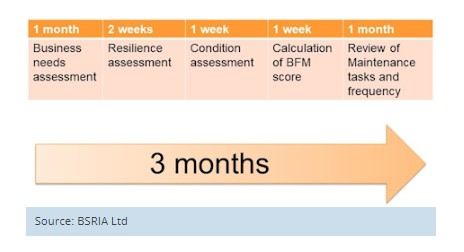Maximising maintenance budgets after lockdown
Contents |
[edit] Introduction
As of June 2020, businesses are reopening across the country and many are inviting people back into their buildings. As we return to buildings that were vacated in, most often, a brusque manner, there are a number of considerations that need to be addressed to bring employees safely in. Once the immediate safety aspect is addressed, we are now looking into the care of our nation’s buildings and their occupants.
[edit] BSRIA Business Focused Maintenance
Business Focused Maintenance (BFM) is a framework to help organisations make sure that maintenance of buildings ensures safe and healthy environments for workers while at the same time managing cost in a most effective way.
BFM looks at the needs of the business and puts them first and foremost. Whether it is a focus on uptime, maintenance costs or environmental impacts, this methodology challenges the planned preventative maintenance frequency of the building services plant.
The assessment methodology takes into account plant history (age, condition, failure history, plant loading and maintenance history), the number of standby plant items (redundancy) and the level of resources available. The six-step process offers an objective approach to a purposeful redefining of a planned preventative maintenance program.
[edit] Condition-based maintenance
Many of the intrusive maintenance tasks can be replaced by condition monitoring (CM) which in turn leads to condition-based maintenance (CBM). The actual practice of CM is far quicker in terms of person-hours than time-based PPMs (Planned preventative maintenance) and often involves zero down time to the asset and therefore no impact to the business. Furthermore, it greatly reduces the incidence of maintenance induced failures.
In addition to the usual array of gauges on an asset or its building management system (BMS) sensor display that can be used to monitor plant performance, common CM methods include thermal imaging, vibration monitoring, acoustic emission monitoring and lubricant analysis. Regular use of these methods at appropriate intervals can be far more cost-effective than regular time-based generic intervals, whereas for non-critical plant, the most cost-effective maintenance methodology may be to run-to-failure.
[edit] Efficient planned preventative maintenance
BFM results in maximum availability of business-critical plant with the minimum required input. The outcome of this equation is time and therefore cost savings, while streamlining the PPM program.
Whilst every job is different, an indicative timeline can show that BFM can very quickly make its impact on a business’s performance and cost.
Since BSRIA first publicised the BFM methodology in 2004, an increasing number of building owners have adopted the methodology. We have conducted BFM in public and private offices, data centres, warehouses, libraries, art galleries, hospitals, care homes, schools and universities and have recently been contacted to provide BFM services to a manufacturing site. The tried and tested BFM method has proven effective in delivering maximum availability of critical plant whilst simultaneously offering environmental sustainability, time and cost savings in a number of different settings.
By applying the BFM methodology, the facilities team can be confident that the most appropriate maintenance technique has been selected for the services in the building to ensure health and safety, operational continuity and maintenance cost control.
The latest version of the BSRIA BFM guidance can be downloaded here.
This article originally appeared on the BSRIA website under the title, 'Maximising maintenance budgets as we return from lockdown'. It was written by Nick Blake, BSRIA Principal FM Consultant and published in June 2020.
--BSRIA
[edit] Related articles on Designing Buildings Wiki
- Benchmarking as business tool.
- BSRIA articles on Designing Buildings Wiki.
- Business focused maintenance.
- Coronavirus and the construction industry.
- Facilities management.
- Facilities management audit FMA.
- Facility condition assessment FCA.
- Hard facilities management.
- ISO/PAS 45005 Guidance for working safely during COVID-19.
- Maintenance.
- Operational costs.
- Planned preventive maintenance.
- Property management.
- Soft facilities management.
[edit] External resources
Featured articles and news
RTPI leader to become new CIOB Chief Executive Officer
Dr Victoria Hills MRTPI, FICE to take over after Caroline Gumble’s departure.
Social and affordable housing, a long term plan for delivery
The “Delivering a Decade of Renewal for Social and Affordable Housing” strategy sets out future path.
A change to adoptive architecture
Effects of global weather warming on architectural detailing, material choice and human interaction.
The proposed publicly owned and backed subsidiary of Homes England, to facilitate new homes.
How big is the problem and what can we do to mitigate the effects?
Overheating guidance and tools for building designers
A number of cool guides to help with the heat.
The UK's Modern Industrial Strategy: A 10 year plan
Previous consultation criticism, current key elements and general support with some persisting reservations.
Building Safety Regulator reforms
New roles, new staff and a new fast track service pave the way for a single construction regulator.
Architectural Technologist CPDs and Communications
CIAT CPD… and how you can do it!
Cooling centres and cool spaces
Managing extreme heat in cities by directing the public to places for heat stress relief and water sources.
Winter gardens: A brief history and warm variations
Extending the season with glass in different forms and terms.
Restoring Great Yarmouth's Winter Gardens
Transforming one of the least sustainable constructions imaginable.
Construction Skills Mission Board launch sector drive
Newly formed government and industry collaboration set strategy for recruiting an additional 100,000 construction workers a year.
New Architects Code comes into effect in September 2025
ARB Architects Code of Conduct and Practice available with ongoing consultation regarding guidance.
Welsh Skills Body (Medr) launches ambitious plan
The new skills body brings together funding and regulation of tertiary education and research for the devolved nation.
Paul Gandy FCIOB announced as next CIOB President
Former Tilbury Douglas CEO takes helm.
UK Infrastructure: A 10 Year Strategy. In brief with reactions
With the National Infrastructure and Service Transformation Authority (NISTA).

























